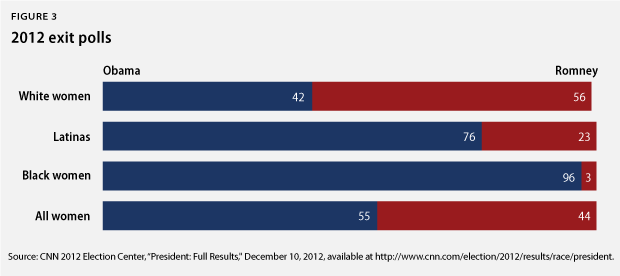Coming out of the 2012 presidential election, women’s role in determining its outcome—the so-called gender gap—was a dominant narrative. Women played a large part in President Barack Obama’s re-election, with 55 percent voting for him compared to 44 percent supporting his Republican rival, former Massachusetts Gov. Mitt Romney.
A parallel narrative last November was that of the potential of the rising electorate—the demographic populations that are increasingly becoming larger segments of the voting-eligible population—influencing election outcomes. Women of color are a particularly important demographic because they stand at the center of the intersection between the rising electorate and the women’s vote.
In this brief, we update the numbers from our October 2012 report, “A Dual Disenfranchisement: How Voter Suppression Denies Reproductive Justice to Women of Color,” which described how women of color are voting at increasing rates yet have been more at risk of disenfranchisement as attacks on voting rights have persisted. This update reflects the most recent data available from the Census Bureau on the voting turnout rates of people of color and women, focusing specifically on the voting power of women of color.
The gender gap
Much has been made of the historic gender gap in the 2012 election. Women were the majority of voters overall, as well as the majority of voters who supported President Obama. Indeed, the gap between the women who voted for President Obama and the men who voted for Gov. Romney was among the largest ever recorded.
The new Census data show that not only were women more likely to vote for the president, they were also more likely to vote overall, which further increased their influence in the outcome of the election.
The rising electorate
The rising electorate encompasses people of color, unmarried women, and young people. Over the past 12 years, members of the rising electorate, especially people of color, have steadily increased their electoral participation. They have become a growing segment of both the overall U.S. population and the voting-eligible population itself.
Reflecting on the Census reports, commentators have already begun to remark on the fact that overall, black voter turnout surpassed white voter turnout. While Latino turnout rates declined slightly from 2008, their share of the electorate grew, rising from 7.4 percent to 8.4 percent in 2012.
Women of color at the intersection
Women of color stand at the intersection of the rising electorate and the gender gap. They currently make up 18 percent of the United States population, and by 2050 the Census Bureau estimates that they will comprise 27 percent of the population. And while the gender gap was found to transcend race, it was sharpest among women of color.
In examining the exit polls from the 2012 election, it is clear that women of color provided the crucial votes that comprised the gender gap. While 42 percent of white women voted for President Obama, 96 percent of black women and 76 percent of Latinas voted for him, leading to a cumulative 55 percent of all women voting for him. Indeed, President Obama did not win white women and, in fact, would have lost the women’s vote without the overwhelming support of women of color.

As we noted in our 2012 report, women of color have been voting at increasing rates since 2000, showing dramatic growth over time. In 2008 black women’s turnout outpaced white women’s for the first time, and their turnout only grew in 2012, breaking 70 percent—a new record. Particularly noteworthy is the steady growth of voter turnout rates of Asian and Pacific Islander, or API, women, which have nearly doubled since 2000, when the Census Bureau first started recording API voter turnout rates. In 2000 24.5 percent of API women voted. In contrast, 48.5 percent voted in 2012. According to Census Bureau data, APIs are the fastest-growing racial group in the general population.
And in 2012, for the first time, women of each race and ethnicity turned out both at greater rates and also in higher numbers than the men in their respective race and ethnic groups, according to the Census data.
Conclusion
So what does this all mean?
Women of color stand at the center of the rising electorate and were the driving force behind the gender gap. They are more likely to vote than the men in their communities, and they are voting at dramatically increasing rates.
This doesn’t come as a great surprise, considering that women of color are disproportionately affected by a variety of critical issues. Some examples include:
- Reproductive rights: All women of color have experienced various forms of reproductive oppression, both throughout history and still to this day. From forced sterilization, childbearing, and removal of their children to restrictions on immigration visas based on hypersexualized myths to targeting of pregnant women of color for drug testing, the examples abound. Women of color are also disproportionately impacted by laws such as the Hyde Amendment, which restricts Medicaid coverage of abortion services.
- Pay equity: Women on average earn 77 cents for every dollar a man earns for comparable work. In comparison, African American and Latina women earn 64 cents and 55 cents, respectively, for every dollar a man earns.
- Immigration reform: Family reunification, protection for survivors of sexual violence and trafficking, and access to health care are all crucial issues that need to be addressed in immigration reform.
The votes cast by women of color were crucial to the outcome of the 2012 election, and the issues that matter to them should remain at the forefront.
Elizabeth Chen is a Policy Analyst for the Women’s Health and Rights Program at the Center for American Progress and a Reproductive Justice Law Fellow.